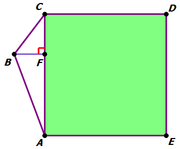
In the diagram above, BF is an altitude drawn to the base AC, and AC is the side of square ACDE. If BF=h, and the area of triangle ABC equals Q, find the area of the square (shaded) in terms of h and Q.
A. hQ
B. q/h
C. 2*(Q/h)^2
D. 4*(Q/h)^2
E. 1/4*(Q/h)^2
The OA is D.
In this PS question, I know that the area of a triangle is equals to,
$$A\triangle=\frac{1}{2}bh,\ where,\ b\ is\ the\ base\ of\ triangle\ and\ h\ it\ altitude.$$
Then in this case, b=AC and h=BF, also I know that, $$\frac{1}{2}bh=Q$$
Now, how can I find the value of the side of the square in terms of Q and then find it area? Experts, I need your help with this PS question please! Thanks!



















